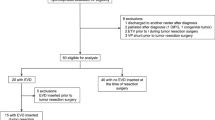Abstract
Background
Focal ventricular obstruction—trapped ventricle—results in cerebrospinal fluid accumulation, mass effect and possible clinical deterioration. There are no systematic studies on the benefit of surgical decompression in adults.
Methods
We reviewed patients admitted with acutely trapped ventricle on brain imaging to assess their prognosis and the effect of surgical intervention on 30-day mortality.
Results
Of the 392 patients with trapped ventricle, the most common causes were brain tumor (45 %), intracerebral hemorrhage (ICH) (20 %), and subdural hematoma (SDH) (14 %). Lateral ventricle trapping accounted for 97 % of cases. Two hundred and twenty-one patients (56 %) received a surgical intervention for trapped ventricle or its causes; 126 (83 %) were treated with craniotomy, 26 (17 %) with craniectomy, 30 (14 %) with external ventricular drain (EVD) alone, 23 (10 %) with ventriculoperitoneal shunt alone, and 16 (7 %) with endoscopic fenestration of the septum pellucidum. Surgical intervention was associated with mortality reduction from 95 % (n = 54) to 48 % (n = 11) in the ICH group, from 47 % (n = 27) to 12 % (n = 15) in the tumor group and from 90 % (n = 18) to 20 % (n = 7) in the SDH group (p < 0.001 for all comparisons). Univariate logistic analysis showed that surgical intervention and tumor etiology were associated with decreased mortality while age, ICH etiology, intraventricular hemorrhage, midline shift, and anticoagulation were associated with increased mortality. On multivariate logistic regression, surgical intervention remained associated with decreased mortality (p < 0.0001; OR 0.20, 95 % CI 0.09–0.42). On subgroup analysis of the ICH cohort, surgical intervention was also associated with decreased mortality (p = 0.028).
Conclusions
Neurosurgical intervention for decompression in patients with trapped ventricle can have a measurable beneficial effect on early mortality.

Similar content being viewed by others
References
Sharma C, Acharya M, Kumawat BL, Kochar A. ‘Trapped temporal horn’ of lateral ventricle in tuberculous meningitis. BMJ Case Rep 2014; Apr 4;2014.
Salcedo-Villanueva G, Rueda-Villa A, Hernández-Ábrego MP. Neurocysticercosis with hydrocephalus and secondary bilateral hemianopia. Arch Soc Esp Oftalmol. 2014;89(1):27–30.
Ogura R, Yoshimura J, Sano M, et al. Entrapment of the inferior horns of the lateral ventricle with enlargement of the bilateral choroid plexus. Neuropathology. 2014;34(2):210–3.
Ferreira M, Nahed BV, Babu MA, Walcott BP, Ellenbogen RG, Sekhar LN. Trapped fourth ventricle phenomenon following aneurysm rupture of the posterior circulation: case reports. Neurosurgery. 2012;70(1):E253–8.
Kamali NI, Huda MF, Srivastava VK. Intraventricular hydatid cyst causing entrapped temporal horn syndrome: case report and review of literature. Trop Parasitol. 2011;1(2):113–5.
Harrison HR, Reynolds AF. Trapped fourth ventricle in coccidioidal meningitis. Surg Neurol. 1982;17(3):197–9.
Kumari R, Raval M, Dhun A. Cryptococcal choroid plexitis: rare imaging findings of central nervous system cryptococcal infection in an immunocompetent individual. Br J Radiol. 2010;83(985):e14–7.
Berhouma M, Abderrazek K, Krichen W, Jemel H. Apropos of an unusual and menacing presentation of neurosarcoidosis: the space-occupying trapped temporal horn. Clin Neurol Neurosurg. 2009;111(2):196–9.
Dhiwakar M, Basu S, Ramaswamy R, Mallucci C. Neurolisteriosis causing hydrocephalus, trapped fourth ventricle, hindbrain herniation and syringomyelia. Br J Neurosurg. 2004;18(4):367–70.
Maurice-Williams RS, Choksey M. Entrapment of the temporal horn: a form of focal obstructive hydrocephalus. J Neurol Neurosurg Psychiatry. 1986;49(3):238–42.
Ogiwara H, Morota N. Endoscopic transaqueductal or interventricular stent placement for the treatment of isolated fourth ventricle and pre-isolated fourth ventricle. Childs Nerv Syst. 2013;29(8):1299–303.
Tseng JS, Lee YC, Pan HC, Chang MH. Motor neuron disease-like syndrome secondary to trapped fourth ventricle and obstruction of cerebrospinal fluid pathway. Clin Neurol Neurosurg. 2007;109(4):383–7.
Lourie H, Shende MC, Krawchenko J, Stewart DH Jr. Trapped fourth ventricle: a report of two unusual cases. Neurosurgery. 1980;7(3):279–82.
Iaccarino C, Romano A, Ramponi V, et al. Entrapment of temporal horn: first case of bilateral occurrence and review of literature. Clin Neurol Neurosurg. 2013;115(10):2207–12.
Hemphill JC 3rd, Bonovich DC, Besmertis L, Manley GT, Johnston SC. The ICH score: a simple, reliable grading scale for intracerebral hemorrhage. Stroke. 2001;32(4):891–7.
Conflict of interest
Gabriel L. Pagani-Estévez, M.D., Philippe Couillard, M.D., Eelco F.M. Wijdicks M.D. Ph.D., and Alejandro A. Rabinstein, M.D. have no conflict of interest. Giuseppe Lanzino, M.D. is a consultant for Cofidien/ev3 but has no conflict of interest with regards to this research study.
Author information
Authors and Affiliations
Corresponding author
Rights and permissions
About this article
Cite this article
Pagani-Estévez, G.L., Couillard, P., Lanzino, G. et al. Acutely Trapped Ventricle: Clinical Significance and Benefit from Surgical Decompression. Neurocrit Care 24, 110–117 (2016). https://doi.org/10.1007/s12028-015-0145-6
Published:
Issue Date:
DOI: https://doi.org/10.1007/s12028-015-0145-6




